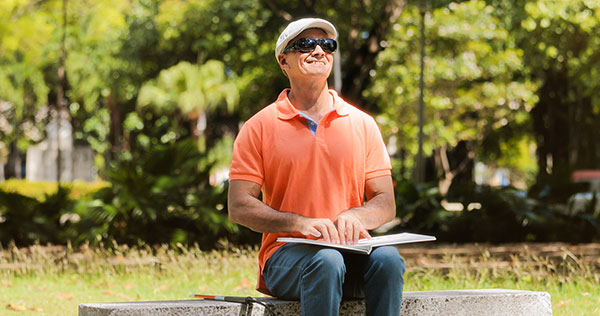Accessibility is a Social Right

I was in a cab heading to LaGuardia Airport on my way to a business meeting in Miami. Although the driver had initially been fearful of my guide dog, the ride was uneventful—until we arrived curbside at the terminal. As we pulled up, he leapt from his seat and shouted at the top of his lungs, “Help him! He can’t see!”
I had asked him to park near an entrance, but his anxiety about the dog and lack of knowledge about blindness gave him license to transform me from a consumer of his services into something to get rid of as fast as possible. I suddenly felt like a toxic substance. Angered by this eruption of what I felt was ignorance, I stepped out of the cab myself. Meanwhile, hearing the commotion, a Skycap came over and asked what was going on. Without waiting for an answer, the Skycap grabbed my arm and started pulling me and my guide dog. I shook him off and blundered into the terminal. Being called out by someone thinking I was helpless had me angry and anxious. I wanted assistance finding my way to the ticket counter and gate, but not help that made me feel small.
This experience had set me on edge—not great preparation for an important business meeting. It clearly stemmed from the common perception that someone with a disability is simply unable to manage life. But turning to the legal question—had the civil rights guaranteed to me by the Americans with Disabilities Act (ADA), including the right to access public buildings, been violated? No. What had been violated was my right of access to a typical social interaction. That was shut down hard.
The ADA has been a workhorse for accessibility over the 30 years it has been law, and it is still regularly pressed into service. In its first week, the Biden White House announced that an American Sign Language interpreter will be present at every press briefing, something no other president has done. Since then, Amtrak settled a federal lawsuit over inaccessibility at 78 stations and will pay $2.25 million to victims and make the stations accessible. Also this year, the NBA’s Golden State Warriors were sued over the inaccessibility of their web site for blind people who use screen readers.
These are all great examples of how the ADA can be harnessed to carve out physical or digital access where it doesn’t exist. But it cannot be used to change behavior from something that upends ordinary social access and norms of community.
Social accessibility is implicit in the law. Common understanding of accessibility is the right of people regardless of ability to participate fully in American life without facing physical and digital barriers that aren’t there for people with typical abilities.
Despite what it can do, the ADA does not govern how we treat each other, and it cannot resolve this fundamental contradiction. It’s one thing to legislate the width of doorways or the percentage and even distribution of accessible rooms in a hotel, or to create a set of guidelines for web developers to follow. It’s entirely something else to boil away peoples’ fears and superstitions, let alone the simple dark unfamiliarity that surrounds the disabled and older adults. These things can’t be legislated or regulated, yet social acceptance is the prerequisite to fulfilling the promise of full accessibility underlying the purpose of the ADA.
As I have become more comfortable as a blind person out in public, I have also influenced the way many people approach me. I can sometimes address disruptive experiences like the one at LaGuardia on the spot, although the curbside encounter left me feeling exposed and raw. Fortunately, by the time I made it to my meeting I was back on track. Still, the possibility of exposing myself to any situation where the mere sight of me can provoke a similar reaction in others puts me in a hyper-vigilant state in which someone’s ignorance about blind people could spark my version of road rage.
What I have learned from lived experiences like those that I describe here is that disability terrifies us. We instantly recognize it could be ours, as if we could catch it. In the COVID-19 era, we know this contagion response more concretely than ever; it tugs at our deepest vulnerabilities and evokes buried consciousness of polio, meningitis, measles, and other diseases that cause blindness, deafness, paralysis.
We grow up learning that these conditions represent the end of useful, enjoyable living—the end of a valuable life. But what really has the power to accomplish end the hopeful trajectory of life is the denial of social accessibility. Without it, the ADA will remain a half-measure.
Lest you think I am making too much out of something so ephemeral and intangible as social interaction, we now have an almost unparalleled example of how social accessibility is empowering. As a youth, Joe Biden could hardly speak. Frustrated, angered and embarrassed at the way his stutter denied him social access, he persisted in remediating his speech until his disability nearly disappeared. This was a transformational act—and it transformed how people treated him and how people came to understand the challenge of stuttering.
Despite growing calls for inclusion, it is still quite common for people to let me know, through language or action, that my long white cane or guide dog flags me as either a pariah to be avoided or a project to be rescued, or something in between: a curiosity—an “other.” No matter how I carry myself and what I project, they are ready to deny me social access, or the ability to choose where to go, what to do and how to do it without finding myself excluded by social barriers.
While I can insist on inclusion all I want, only when the people who maintain those barriers recognize that they are also denying themselves the fruits of social accessibility will they be able to see me as simply another person.
 Contributor Peter Slatin is a disability consultant and advocate in New York City and an award-winning journalist. He is an Encore Public Voices Fellow with The Op-Ed Project. This article was originally published by the Harvard Advanced Leadership Institute in its Social Impact Review on May 18, 2021.
Contributor Peter Slatin is a disability consultant and advocate in New York City and an award-winning journalist. He is an Encore Public Voices Fellow with The Op-Ed Project. This article was originally published by the Harvard Advanced Leadership Institute in its Social Impact Review on May 18, 2021.
![AgeWise King County [logo]](https://www.agewisekingcounty.org/wp-content/themes/agewisekingcounty/images/logo.png)